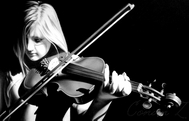31. Notes for Yourself
Here are some exercises to learn the notes on your instrument. If you're a vocalist, sing a note, and hear the interval (step) to the next note. Each tone has a distinct relationship with the other. We'll measure these pitch intervals (sound distances between notes).
Intervals
Thirds are an exercise that starts on the root note of a Major scale, then moves up to the third (remember triads?), then goes down to the 2nd note, then up to the 4th note, then down to the 3rd, then up to the 5th ... You can better understand it visually, ascending from C:
Going down is the opposite:
Don't worry about the numbers, because the tones, or letters, are more important. This was from the Major scale.
We may use these interval phrases in improvisation, when we need a filler between inspired melodies. Also, we may practice any interval the same way, such as Fourths, Fifths, etc. Just keep the intervals the same with every note, going up and down.
The sound for the exercise changes with each new interval jump, so we may memorize their steps by listening closely.
Play these in any key, with Major or minor scales, as long as the intervals remain the same (3rd's, 4th's, or 5th's etc.). Simply keep the sharps or flats for that particular key. Example for Fourths, in the key of A:
And intervals of 4, going down in sound:
These may be played in any rhythm we imagine. They help us to learn key signatures as well.
Scaling Shortcuts
Also, to learn key signatures, here's some practice:With any scale, Major or minor, we land on the root note when the scale is finished (going up, then down the scale). However, we could land on the next note (2nd) in that scale, then play a scale that changes the key to match that note (the new root). Then continuing, we land on that scale's 2nd note, and change the key to that new note. Starting on C (going up and down):
- C D E F G A B C B A G F E
- D E F# G A B C# D C# B A G F#
- E F# G# A B C# D# E D# C# B A G# F# (F#'s Enharmonic is Gb)
- Gb Ab Bb Cb Db Eb F Gb F Eb Db Cb Bb (flat all notes but F)
- Ab Bb C ... etc.
We used the C, D, E, Gb, and Ab Major scales above, and added sharps or flats for the new root's key. Review the Order of sharps and flats, if you're having trouble with the keys (it'll reinforce your memorization of the keys, which is the cornerstone for improv)!
Use this method for Chromatics (half steps) as well. It's easier with chromatics because you only have to remember the starting note, not the key.
32. Piece by Piece Practice
Beginners tend to play what they have learned, at a speed that creates errors. But we can learn a phrase correctly with this method:
Play whatever phrase or song you have learned, at a comfortable pace. Listen critically for mistakes, such as wrong notes, repeated notes, starting and stopping, and the blurbs of your particular instrument.
Where a mistake occurs, start again, slower, and play up to that mistake. Do this a few times, until you can play over that part. If it is particularly difficult, play only up to the note you're missing. Do this until there's little effort to get to that note.
Next, start from that note only, and play a little farther. Repeat this a few times, until it's comfortable.
Now, add the beginning, up to the mistake, to the part after the mistake. If you still have an error, repeat the process of before the mistake, then after the mistake, then adding them together. You'll realize you must play slower, at a steady rhythm, to help understand what you're missing.
Continue playing the song until the next mistake. If you string enough of these practice sessions together, you'll find you will progress nicely through any problematic piece.
Frustration is inevitable, but even video games, which are supposed to be fun, have challenges to get to the next level. The payback will come when you realize how well you can play.
Playing Together with Teamwork
Tips for Band, Orchestra, Choir:
- Blend with the rest of the sound (don't play loudly to be heard above others, unless soloing). Listen to the other sounds as you play.
- Support the melody by playing under it, and support the blank spaces with fills and countermelody.
- Play dynamically (crescendos, decrescendos, accents, articulations).
- Listen to your drummer and percussionist.
Percussionists: Don't slow down with the band, but do not speed up the tempo since they're listening to you. Follow the other tips above.
Coordinating sounds by cooperation helps the musicians' intonation and rhythm, and gives the audience a great show!
Recommended reading: Tools of Sound
The next page refines your sound by spicing up notes' personality.

